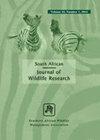Environmental Correlates of Cheetah (Acinonyx jubatus) Space-Use in a Savanna Landscape
引用次数: 3
Abstract
Understanding the environmental drivers that influence the spatial distribution of wildlife is paramount to the conservation of endangered carnivore species. However, presence data on most carnivore species (e.g. cheetah, Acinonyx jubatus) are not readily available to assist conservation efforts. In this study, we used MaxEnt to tease out the key determinants of the spatial distribution of cheetahs using presence-only data of cheetah against five environmental variables, i.e. distance to water (a proxy for prey density), elevation, slope, terrain ruggedness, and soil adjusted vegetation index (SAVI; a proxy for vegetation quality and condition). Our MaxEnt model was successful (AUC = 0.98) in predicting the potential distribution of cheetahs in Gonarezhou National Park. We observed that amongst the five environmental variables, elevation and distance to water contributed most (88%) to the potential distribution of cheetahs. The contribution of SAVI, slope and terrain ruggedness (12%) was negligible. We also estimated that the potential predicted habitat of cheetahs was 2572.9 km2 (51.2% of Gonarezhou National Park). In addition to providing baseline information, these findings are both novel and specific to Gonarezhou National Park, and provide important insights into cheetah conservation and management.草原景观中猎豹空间利用的环境相关性
了解影响野生动物空间分布的环境驱动因素对于保护濒危食肉动物物种至关重要。然而,大多数食肉动物物种(如猎豹、朱巴豆)的存在数据并不容易用于协助保护工作。在这项研究中,我们使用MaxEnt,利用猎豹的仅存在数据,对照五个环境变量,即离水距离(猎物密度的指标)、海拔、坡度、地形崎岖度和土壤调整植被指数(SAVI;植被质量和条件的指标),梳理出猎豹空间分布的关键决定因素。我们的MaxEnt模型在预测戈纳雷州国家公园猎豹的潜在分布方面是成功的(AUC=0.98)。我们观察到,在五个环境变量中,海拔和离水距离对猎豹的潜在分布贡献最大(88%)。SAVI、坡度和地形崎岖度(12%)的贡献可以忽略不计。我们还估计,猎豹的潜在预测栖息地为2572.9平方公里(占戈纳雷州国家公园的51.2%)。除了提供基线信息外,这些发现对戈纳雷州国家公园来说既新颖又独特,为猎豹的保护和管理提供了重要见解。
本文章由计算机程序翻译,如有差异,请以英文原文为准。
求助全文
约1分钟内获得全文
求助全文

 求助内容:
求助内容: 应助结果提醒方式:
应助结果提醒方式:


